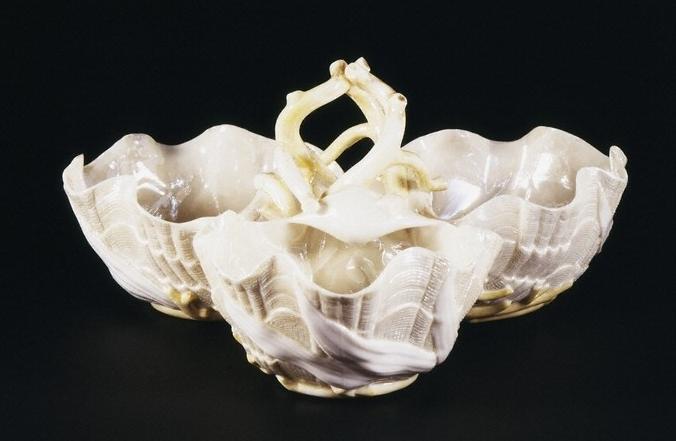Image: Belleek
Description: Dessert stand, 1857-1871, Belleek Porcelain Factory V&A Museum no. 3886-1901 Techniques - Porcelain, with a lustrous glaze Place - Fermanagh, Northern Ireland Dimensions - Height 11 cm, Width 24.5 cm Object Type - This is a decorative stand for serving fruit or sweetmeats and could have been used on a variety of occasions. The Belleek ceramics factory in Ireland specialised in intricately modelled wares for which its fine porcelain and thin, lustrous glaze was especially suited. Requiring careful handling, such wares would have been for 'Sunday' or 'best' use only. Manufacturer - John Bloomfield, the proprietor of Castle Caldwell on Lower Lough Erne, in Northern Ireland, discovered deposits of feldspar on his estates in 1852. The 1851 Great Exhibition in London had already stimulated his interest in ceramics. Worcester, and later other English companies, imported feldspar and the subsequently discovered kaolin (porcelain clay) from Castle Caldwell. With advice from W.H. Kerr of the Royal Porcelain Works, Worcester, Bloomfield ran trials in ceramic manufacture. Production had started by 1863 (possibly as early as 1857) with utilitarian earthenware kitchenwares and dinnerwares, sometimes transfer-printed. By the Dublin Exhibition held in Ireland in 1865 the company, now called Belleek, was able to exhibit stonewares, earthenwares and 'Parian' (unglazed white 'statuary' porcelain) figures. About 1869 orders were placed by the Royal Family. Materials & Making - The Belleek factory began experimenting with porcelain production in 1863 on the arrival of William Bromley. He was previously foreman at the Staffordshire factory of W.H. Goss (1833-1906). The factory developed a truly hard porcelain using a high percentage of feldspar to kaolin. The shrinkage rate in the firing was considerable (one figure is known have reduced in size from 87 centimetres to 61 centimetres). This accounts for the celebrated thinness of Belleek's fine porcelain. The company also bought the patent for a lustrous glaze developed by the Frenchman J.J. Brianchon (died 1880). It was a great commercial success, and the wares produced with this glaze are among the most distinctive of Belleek's manufacture. The thinness of the porcelain and the iridescent glaze also encouraged the Belleek modellers to make extravagantly fantastical forms.
Title: Belleek
Credit: https://collections.vam.ac.uk/item/O77575/dessert-stand/
Author: VAwebteam at English Wikipedia
Usage Terms: Creative Commons Attribution-Share Alike 3.0
License: CC-BY-SA-3.0
License Link: http://creativecommons.org/licenses/by-sa/3.0/
Attribution Required?: Yes
Image usage
The following page links to this image:


